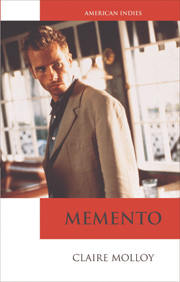Book contents
- Frontmatter
- Contents
- Series Preface
- Acknowledgements
- Dedication
- Introduction: Memento
- 1 Memento and Independent Cinema: A Seductive Business
- 2 Searching for a Slam Dunk: Marketing Memento
- 3 Puzzle Films, Ambiguity and Technologically-enabled Narrative
- 4 Memento as Noir
- 5 So What Really Happened? Memento, Fans and Online Interpretive Strategies
- Notes
- Bibliography
- Index
1 - Memento and Independent Cinema: A Seductive Business
Published online by Cambridge University Press: 05 August 2013
- Frontmatter
- Contents
- Series Preface
- Acknowledgements
- Dedication
- Introduction: Memento
- 1 Memento and Independent Cinema: A Seductive Business
- 2 Searching for a Slam Dunk: Marketing Memento
- 3 Puzzle Films, Ambiguity and Technologically-enabled Narrative
- 4 Memento as Noir
- 5 So What Really Happened? Memento, Fans and Online Interpretive Strategies
- Notes
- Bibliography
- Index
Summary
‘We're financiers, not movie people.’
‘It's a seductive business, but we're certainly not seduced by it.’
William Tyrer and Christopher Ball, co-founders of Newmarket Group
By the time Memento reached Sundance in 2001, a series of corporate takeovers and mergers, which had started in the early 1990s, notably including New Line Cinema and Miramax in 1993, had dramatically reshaped the independent sector. New Line Cinema had been established in 1967 as an independent non-theatrical distributor until, in 1973, the company moved into the distribution of exploitation and art movies. Targeting the markets that the majors ignored, New Line's roster included George Romero's Night of the Living Dead (1968), Jean-Luc Godard's Sympathy for the Devil (1968), John Waters’ Pink Flamingos (1972) and Hooper's The Texas Chainsaw Massacre (1974). In the early 1980s New Line found commercial success with the Nightmare on Elm Street franchise. The first film in the series, directed by Wes Craven in 1984 with a budget of less than $2 million, took more than $10 million at the domestic box office and the next three Nightmare on Elm Street films continued to record healthy box office grosses of $23 million, $44 million and $45 million respectively. New Line was able to follow this success with a second franchise and, in the 1990s, the first of four films in the Teenage Mutant Ninja Turtles series took over $135 million at the domestic box office. This success attracted the attention of Ted Turner, and New Line was bought in 1993 by Turner Broadcasting System which then merged with Time Warner in 1996.
- Type
- Chapter
- Information
- Memento , pp. 8 - 25Publisher: Edinburgh University PressPrint publication year: 2010



